Effect of Price on Demand and Supply in Economics
VerifiedAdded on 2023/06/05
|13
|2758
|197
AI Summary
This paper studies the effect of a price reduction or increase on the demand and supply of a quantity of a product in a market. It covers topics such as the law of demand and supply, normal goods, inferior goods, substitutes, complement, and negative externalities.
Contribute Materials
Your contribution can guide someone’s learning journey. Share your
documents today.
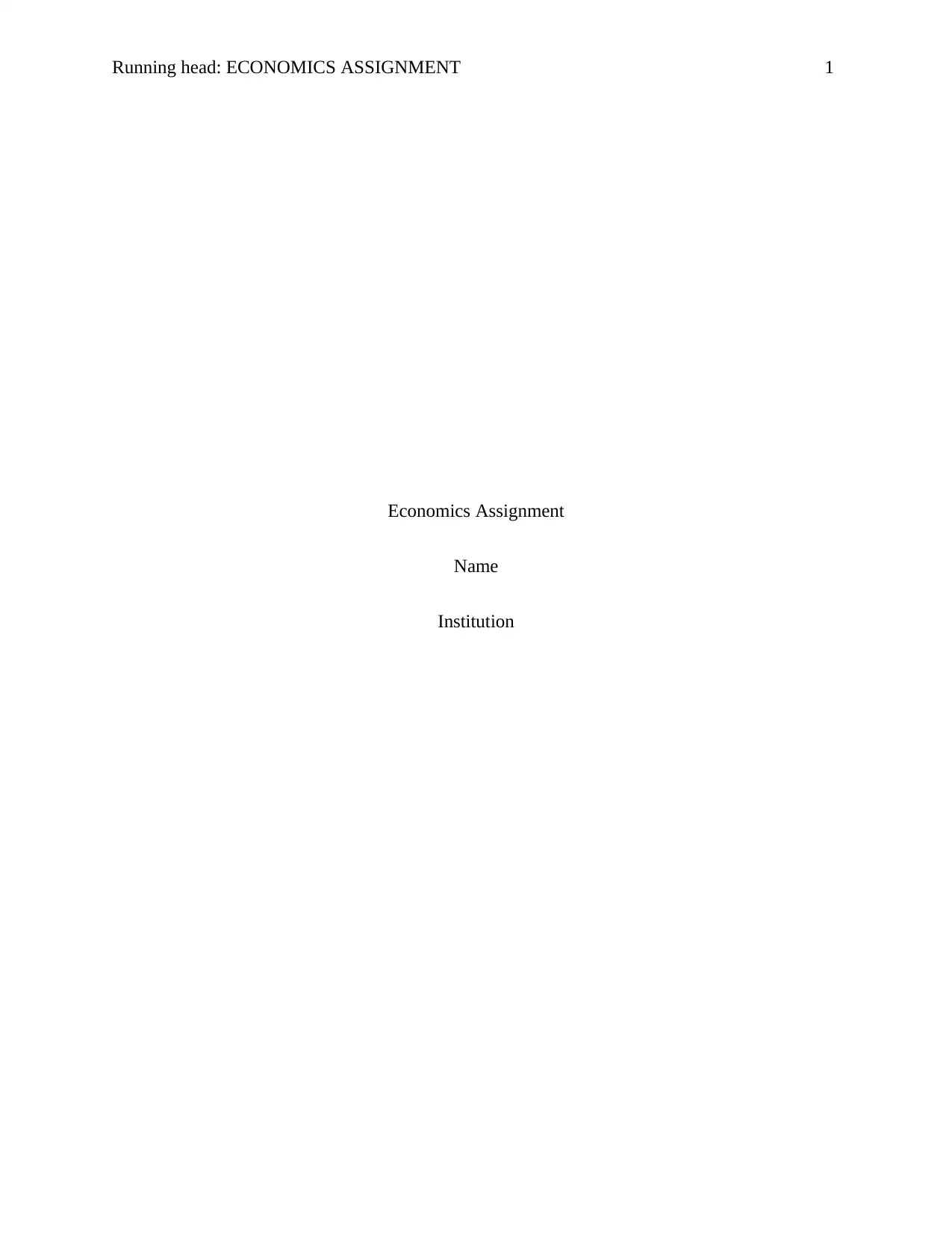
Running head: ECONOMICS ASSIGNMENT 1
Economics Assignment
Name
Institution
Economics Assignment
Name
Institution
Secure Best Marks with AI Grader
Need help grading? Try our AI Grader for instant feedback on your assignments.
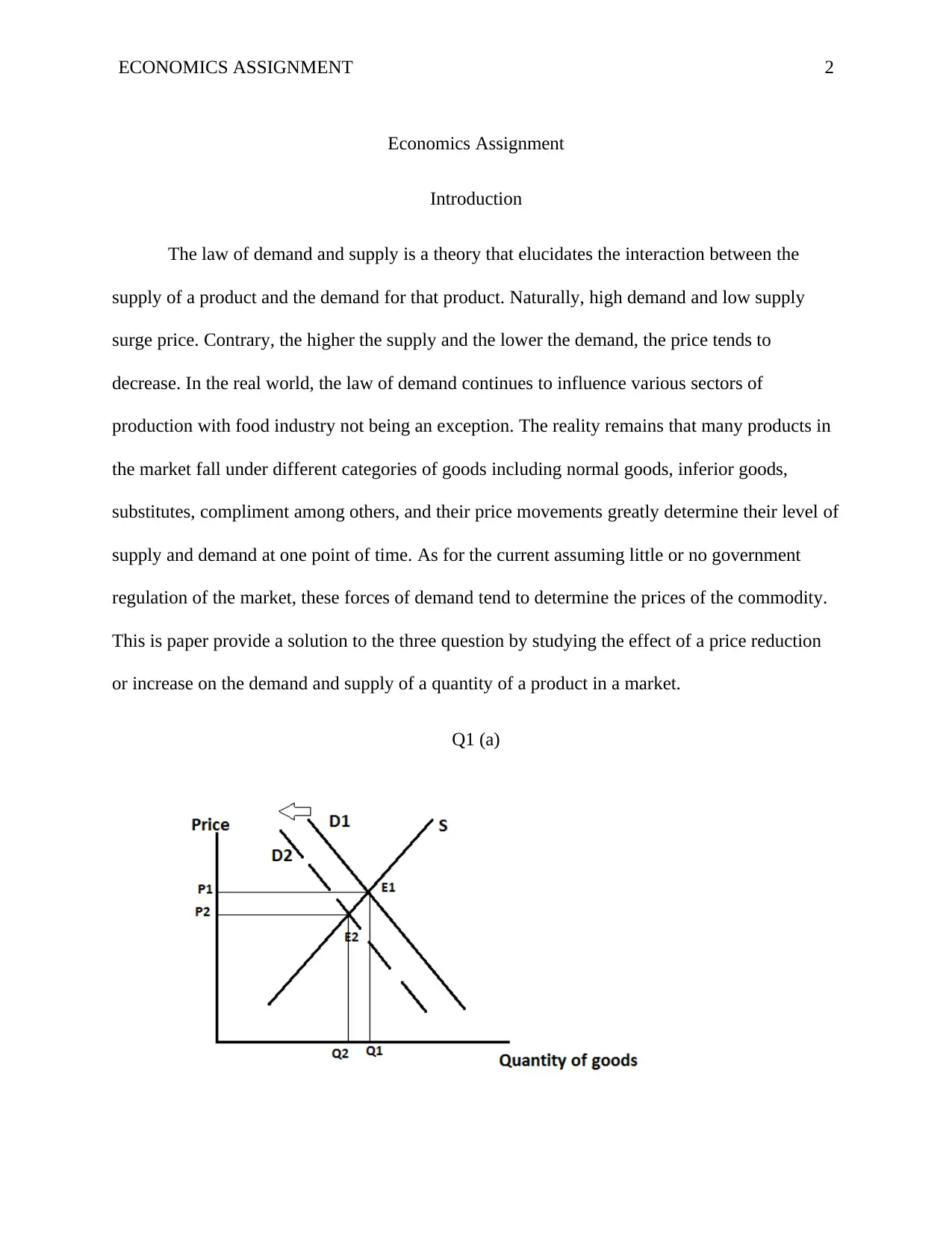
ECONOMICS ASSIGNMENT 2
Economics Assignment
Introduction
The law of demand and supply is a theory that elucidates the interaction between the
supply of a product and the demand for that product. Naturally, high demand and low supply
surge price. Contrary, the higher the supply and the lower the demand, the price tends to
decrease. In the real world, the law of demand continues to influence various sectors of
production with food industry not being an exception. The reality remains that many products in
the market fall under different categories of goods including normal goods, inferior goods,
substitutes, compliment among others, and their price movements greatly determine their level of
supply and demand at one point of time. As for the current assuming little or no government
regulation of the market, these forces of demand tend to determine the prices of the commodity.
This is paper provide a solution to the three question by studying the effect of a price reduction
or increase on the demand and supply of a quantity of a product in a market.
Q1 (a)
Economics Assignment
Introduction
The law of demand and supply is a theory that elucidates the interaction between the
supply of a product and the demand for that product. Naturally, high demand and low supply
surge price. Contrary, the higher the supply and the lower the demand, the price tends to
decrease. In the real world, the law of demand continues to influence various sectors of
production with food industry not being an exception. The reality remains that many products in
the market fall under different categories of goods including normal goods, inferior goods,
substitutes, compliment among others, and their price movements greatly determine their level of
supply and demand at one point of time. As for the current assuming little or no government
regulation of the market, these forces of demand tend to determine the prices of the commodity.
This is paper provide a solution to the three question by studying the effect of a price reduction
or increase on the demand and supply of a quantity of a product in a market.
Q1 (a)
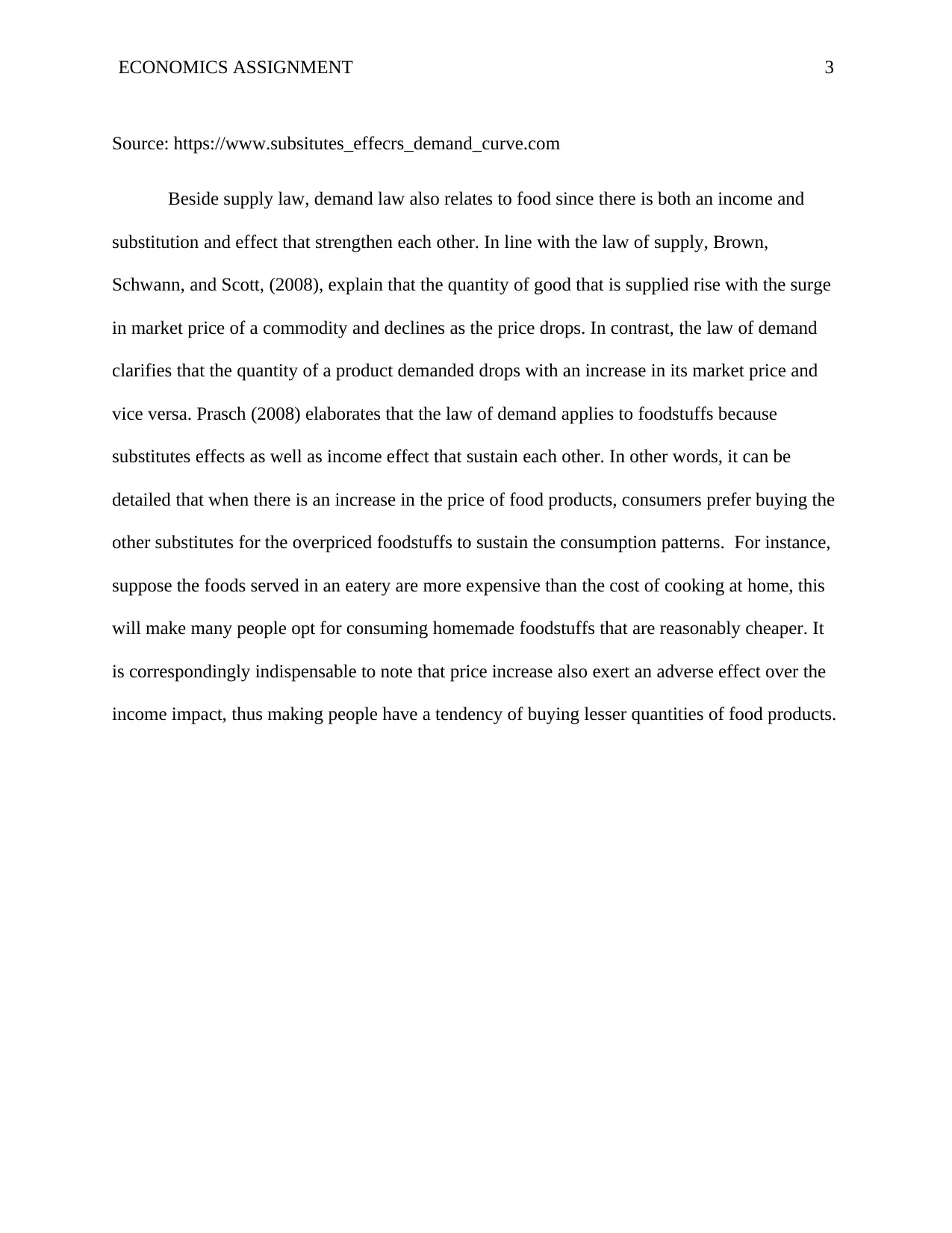
ECONOMICS ASSIGNMENT 3
Source: https://www.subsitutes_effecrs_demand_curve.com
Beside supply law, demand law also relates to food since there is both an income and
substitution and effect that strengthen each other. In line with the law of supply, Brown,
Schwann, and Scott, (2008), explain that the quantity of good that is supplied rise with the surge
in market price of a commodity and declines as the price drops. In contrast, the law of demand
clarifies that the quantity of a product demanded drops with an increase in its market price and
vice versa. Prasch (2008) elaborates that the law of demand applies to foodstuffs because
substitutes effects as well as income effect that sustain each other. In other words, it can be
detailed that when there is an increase in the price of food products, consumers prefer buying the
other substitutes for the overpriced foodstuffs to sustain the consumption patterns. For instance,
suppose the foods served in an eatery are more expensive than the cost of cooking at home, this
will make many people opt for consuming homemade foodstuffs that are reasonably cheaper. It
is correspondingly indispensable to note that price increase also exert an adverse effect over the
income impact, thus making people have a tendency of buying lesser quantities of food products.
Source: https://www.subsitutes_effecrs_demand_curve.com
Beside supply law, demand law also relates to food since there is both an income and
substitution and effect that strengthen each other. In line with the law of supply, Brown,
Schwann, and Scott, (2008), explain that the quantity of good that is supplied rise with the surge
in market price of a commodity and declines as the price drops. In contrast, the law of demand
clarifies that the quantity of a product demanded drops with an increase in its market price and
vice versa. Prasch (2008) elaborates that the law of demand applies to foodstuffs because
substitutes effects as well as income effect that sustain each other. In other words, it can be
detailed that when there is an increase in the price of food products, consumers prefer buying the
other substitutes for the overpriced foodstuffs to sustain the consumption patterns. For instance,
suppose the foods served in an eatery are more expensive than the cost of cooking at home, this
will make many people opt for consuming homemade foodstuffs that are reasonably cheaper. It
is correspondingly indispensable to note that price increase also exert an adverse effect over the
income impact, thus making people have a tendency of buying lesser quantities of food products.
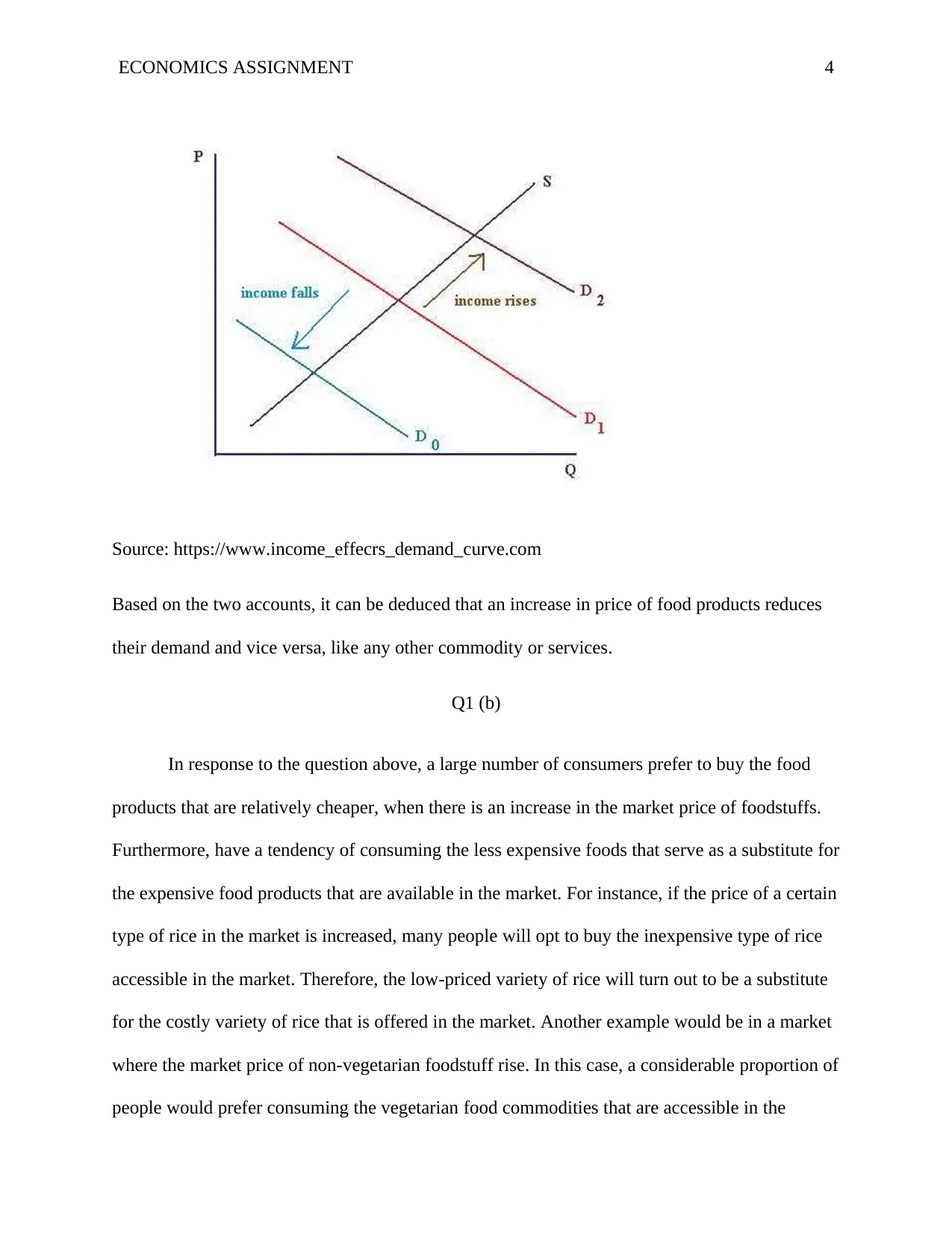
ECONOMICS ASSIGNMENT 4
Source: https://www.income_effecrs_demand_curve.com
Based on the two accounts, it can be deduced that an increase in price of food products reduces
their demand and vice versa, like any other commodity or services.
Q1 (b)
In response to the question above, a large number of consumers prefer to buy the food
products that are relatively cheaper, when there is an increase in the market price of foodstuffs.
Furthermore, have a tendency of consuming the less expensive foods that serve as a substitute for
the expensive food products that are available in the market. For instance, if the price of a certain
type of rice in the market is increased, many people will opt to buy the inexpensive type of rice
accessible in the market. Therefore, the low-priced variety of rice will turn out to be a substitute
for the costly variety of rice that is offered in the market. Another example would be in a market
where the market price of non-vegetarian foodstuff rise. In this case, a considerable proportion of
people would prefer consuming the vegetarian food commodities that are accessible in the
Source: https://www.income_effecrs_demand_curve.com
Based on the two accounts, it can be deduced that an increase in price of food products reduces
their demand and vice versa, like any other commodity or services.
Q1 (b)
In response to the question above, a large number of consumers prefer to buy the food
products that are relatively cheaper, when there is an increase in the market price of foodstuffs.
Furthermore, have a tendency of consuming the less expensive foods that serve as a substitute for
the expensive food products that are available in the market. For instance, if the price of a certain
type of rice in the market is increased, many people will opt to buy the inexpensive type of rice
accessible in the market. Therefore, the low-priced variety of rice will turn out to be a substitute
for the costly variety of rice that is offered in the market. Another example would be in a market
where the market price of non-vegetarian foodstuff rise. In this case, a considerable proportion of
people would prefer consuming the vegetarian food commodities that are accessible in the
Secure Best Marks with AI Grader
Need help grading? Try our AI Grader for instant feedback on your assignments.
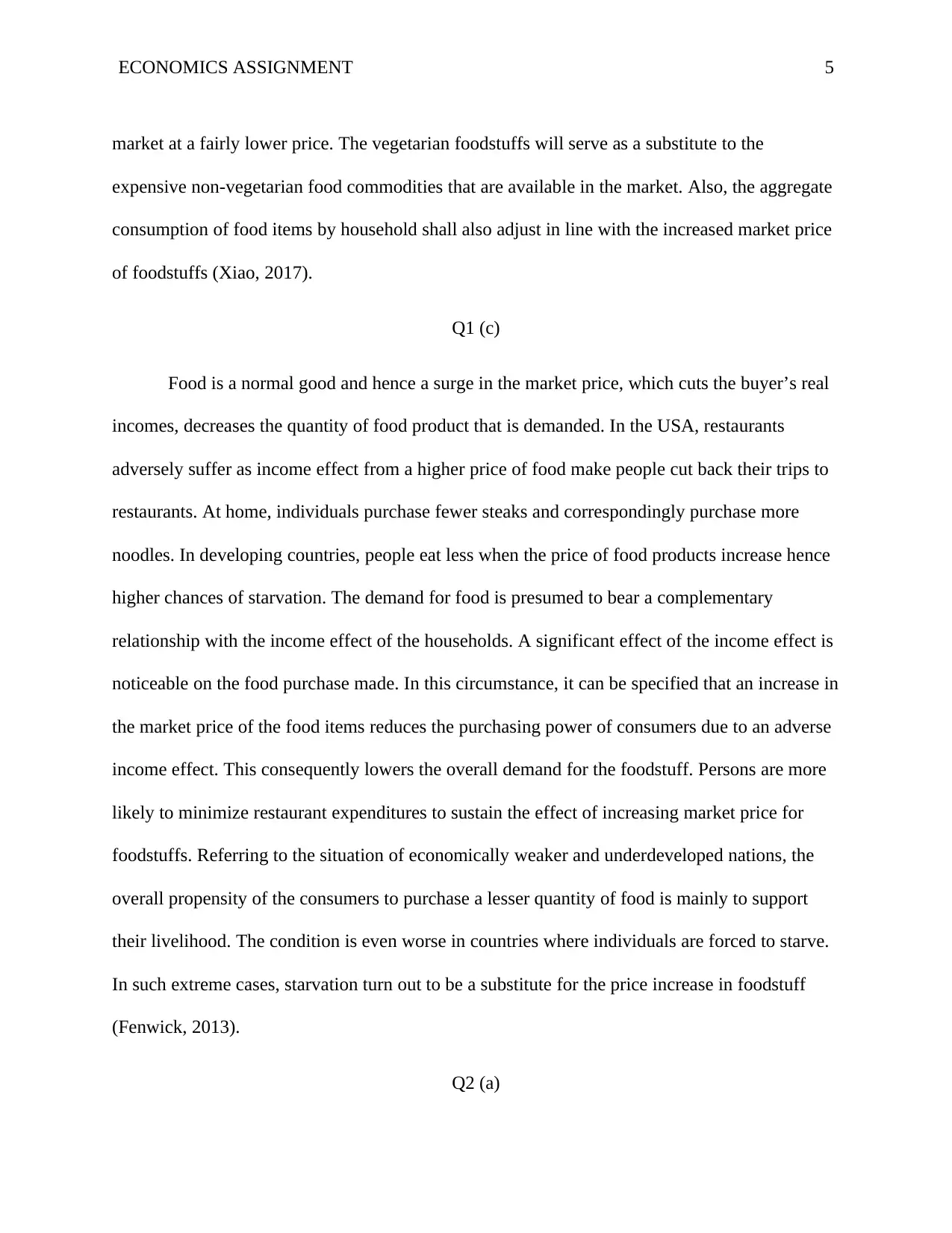
ECONOMICS ASSIGNMENT 5
market at a fairly lower price. The vegetarian foodstuffs will serve as a substitute to the
expensive non-vegetarian food commodities that are available in the market. Also, the aggregate
consumption of food items by household shall also adjust in line with the increased market price
of foodstuffs (Xiao, 2017).
Q1 (c)
Food is a normal good and hence a surge in the market price, which cuts the buyer’s real
incomes, decreases the quantity of food product that is demanded. In the USA, restaurants
adversely suffer as income effect from a higher price of food make people cut back their trips to
restaurants. At home, individuals purchase fewer steaks and correspondingly purchase more
noodles. In developing countries, people eat less when the price of food products increase hence
higher chances of starvation. The demand for food is presumed to bear a complementary
relationship with the income effect of the households. A significant effect of the income effect is
noticeable on the food purchase made. In this circumstance, it can be specified that an increase in
the market price of the food items reduces the purchasing power of consumers due to an adverse
income effect. This consequently lowers the overall demand for the foodstuff. Persons are more
likely to minimize restaurant expenditures to sustain the effect of increasing market price for
foodstuffs. Referring to the situation of economically weaker and underdeveloped nations, the
overall propensity of the consumers to purchase a lesser quantity of food is mainly to support
their livelihood. The condition is even worse in countries where individuals are forced to starve.
In such extreme cases, starvation turn out to be a substitute for the price increase in foodstuff
(Fenwick, 2013).
Q2 (a)
market at a fairly lower price. The vegetarian foodstuffs will serve as a substitute to the
expensive non-vegetarian food commodities that are available in the market. Also, the aggregate
consumption of food items by household shall also adjust in line with the increased market price
of foodstuffs (Xiao, 2017).
Q1 (c)
Food is a normal good and hence a surge in the market price, which cuts the buyer’s real
incomes, decreases the quantity of food product that is demanded. In the USA, restaurants
adversely suffer as income effect from a higher price of food make people cut back their trips to
restaurants. At home, individuals purchase fewer steaks and correspondingly purchase more
noodles. In developing countries, people eat less when the price of food products increase hence
higher chances of starvation. The demand for food is presumed to bear a complementary
relationship with the income effect of the households. A significant effect of the income effect is
noticeable on the food purchase made. In this circumstance, it can be specified that an increase in
the market price of the food items reduces the purchasing power of consumers due to an adverse
income effect. This consequently lowers the overall demand for the foodstuff. Persons are more
likely to minimize restaurant expenditures to sustain the effect of increasing market price for
foodstuffs. Referring to the situation of economically weaker and underdeveloped nations, the
overall propensity of the consumers to purchase a lesser quantity of food is mainly to support
their livelihood. The condition is even worse in countries where individuals are forced to starve.
In such extreme cases, starvation turn out to be a substitute for the price increase in foodstuff
(Fenwick, 2013).
Q2 (a)
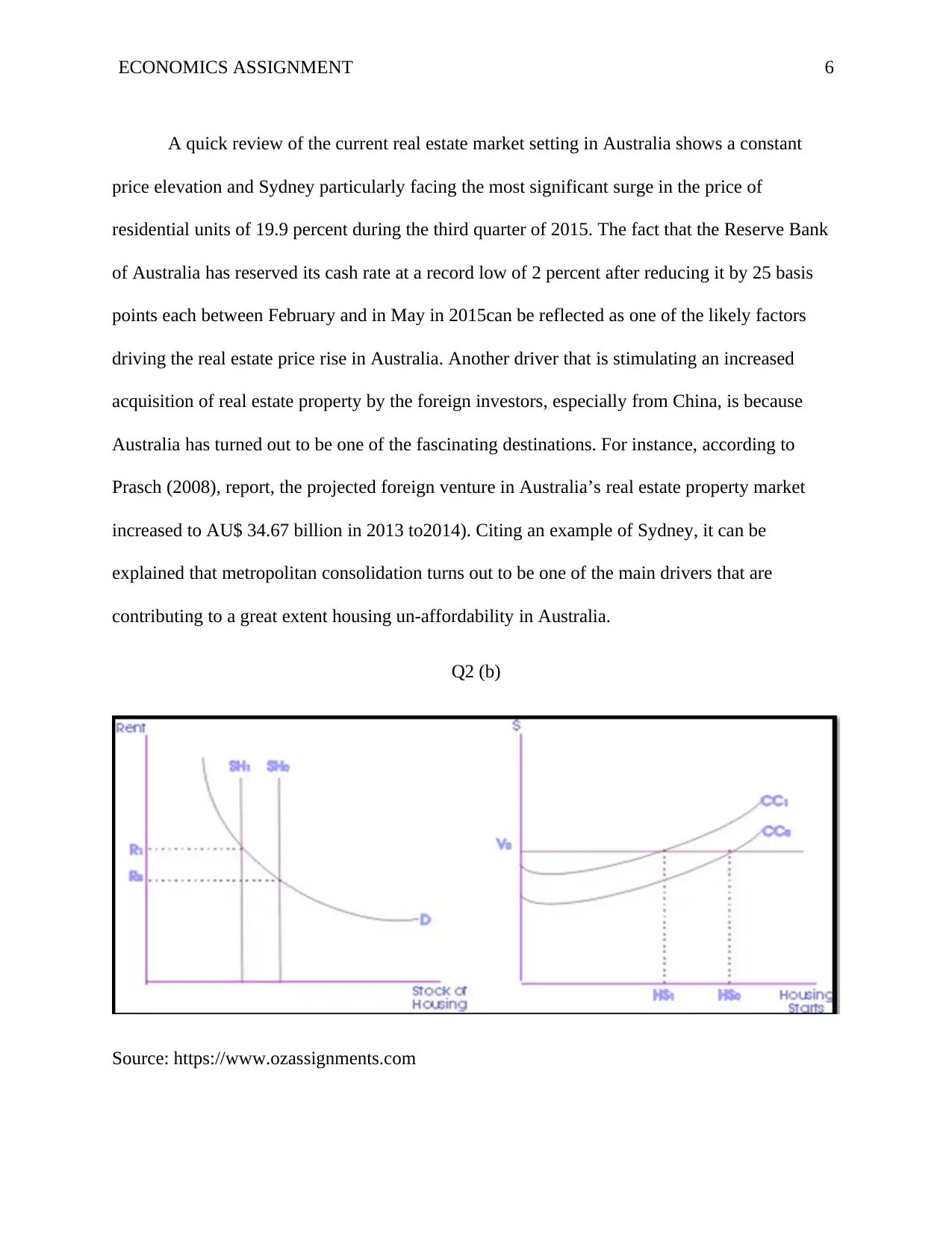
ECONOMICS ASSIGNMENT 6
A quick review of the current real estate market setting in Australia shows a constant
price elevation and Sydney particularly facing the most significant surge in the price of
residential units of 19.9 percent during the third quarter of 2015. The fact that the Reserve Bank
of Australia has reserved its cash rate at a record low of 2 percent after reducing it by 25 basis
points each between February and in May in 2015can be reflected as one of the likely factors
driving the real estate price rise in Australia. Another driver that is stimulating an increased
acquisition of real estate property by the foreign investors, especially from China, is because
Australia has turned out to be one of the fascinating destinations. For instance, according to
Prasch (2008), report, the projected foreign venture in Australia’s real estate property market
increased to AU$ 34.67 billion in 2013 to2014). Citing an example of Sydney, it can be
explained that metropolitan consolidation turns out to be one of the main drivers that are
contributing to a great extent housing un-affordability in Australia.
Q2 (b)
Source: https://www.ozassignments.com
A quick review of the current real estate market setting in Australia shows a constant
price elevation and Sydney particularly facing the most significant surge in the price of
residential units of 19.9 percent during the third quarter of 2015. The fact that the Reserve Bank
of Australia has reserved its cash rate at a record low of 2 percent after reducing it by 25 basis
points each between February and in May in 2015can be reflected as one of the likely factors
driving the real estate price rise in Australia. Another driver that is stimulating an increased
acquisition of real estate property by the foreign investors, especially from China, is because
Australia has turned out to be one of the fascinating destinations. For instance, according to
Prasch (2008), report, the projected foreign venture in Australia’s real estate property market
increased to AU$ 34.67 billion in 2013 to2014). Citing an example of Sydney, it can be
explained that metropolitan consolidation turns out to be one of the main drivers that are
contributing to a great extent housing un-affordability in Australia.
Q2 (b)
Source: https://www.ozassignments.com
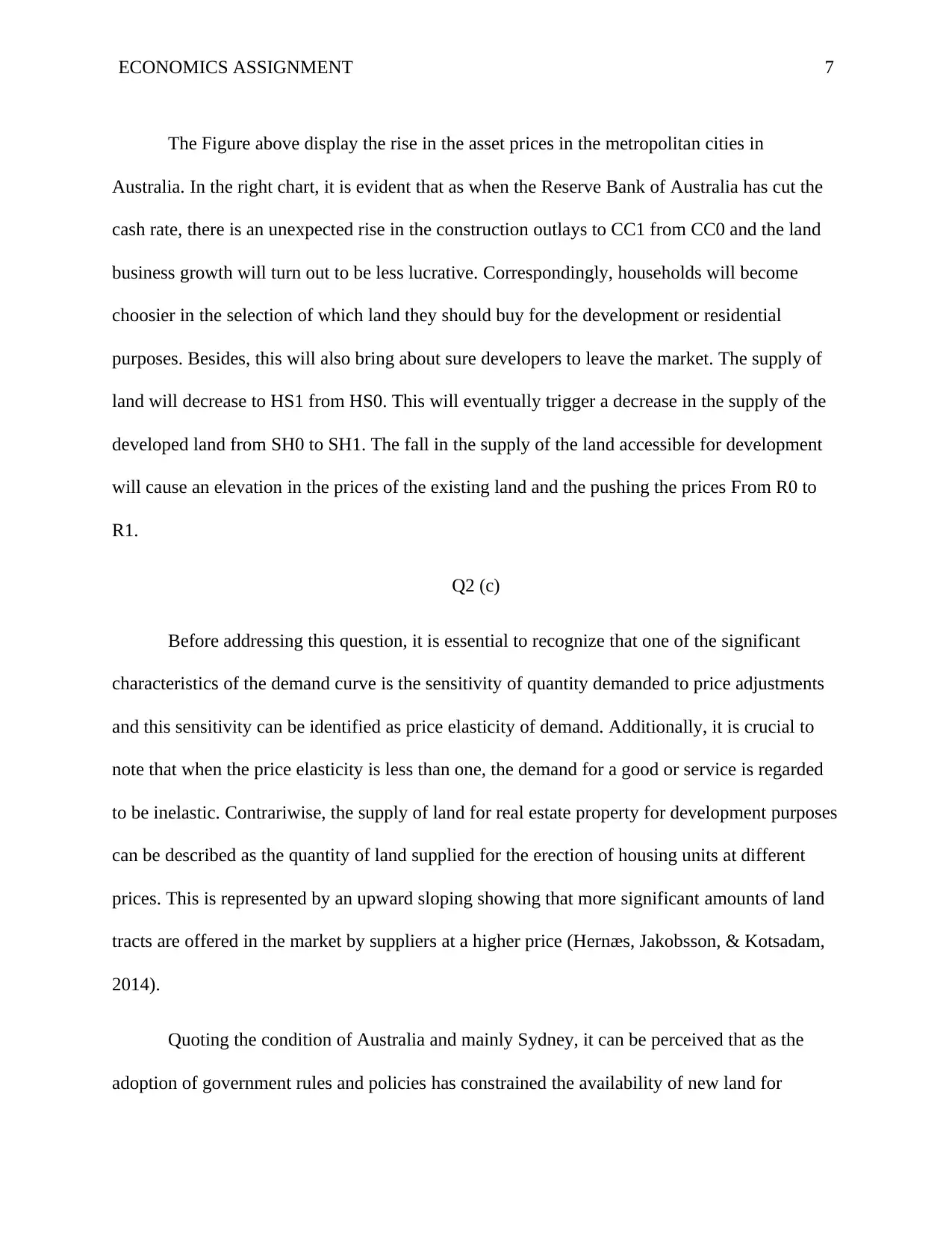
ECONOMICS ASSIGNMENT 7
The Figure above display the rise in the asset prices in the metropolitan cities in
Australia. In the right chart, it is evident that as when the Reserve Bank of Australia has cut the
cash rate, there is an unexpected rise in the construction outlays to CC1 from CC0 and the land
business growth will turn out to be less lucrative. Correspondingly, households will become
choosier in the selection of which land they should buy for the development or residential
purposes. Besides, this will also bring about sure developers to leave the market. The supply of
land will decrease to HS1 from HS0. This will eventually trigger a decrease in the supply of the
developed land from SH0 to SH1. The fall in the supply of the land accessible for development
will cause an elevation in the prices of the existing land and the pushing the prices From R0 to
R1.
Q2 (c)
Before addressing this question, it is essential to recognize that one of the significant
characteristics of the demand curve is the sensitivity of quantity demanded to price adjustments
and this sensitivity can be identified as price elasticity of demand. Additionally, it is crucial to
note that when the price elasticity is less than one, the demand for a good or service is regarded
to be inelastic. Contrariwise, the supply of land for real estate property for development purposes
can be described as the quantity of land supplied for the erection of housing units at different
prices. This is represented by an upward sloping showing that more significant amounts of land
tracts are offered in the market by suppliers at a higher price (Hernæs, Jakobsson, & Kotsadam,
2014).
Quoting the condition of Australia and mainly Sydney, it can be perceived that as the
adoption of government rules and policies has constrained the availability of new land for
The Figure above display the rise in the asset prices in the metropolitan cities in
Australia. In the right chart, it is evident that as when the Reserve Bank of Australia has cut the
cash rate, there is an unexpected rise in the construction outlays to CC1 from CC0 and the land
business growth will turn out to be less lucrative. Correspondingly, households will become
choosier in the selection of which land they should buy for the development or residential
purposes. Besides, this will also bring about sure developers to leave the market. The supply of
land will decrease to HS1 from HS0. This will eventually trigger a decrease in the supply of the
developed land from SH0 to SH1. The fall in the supply of the land accessible for development
will cause an elevation in the prices of the existing land and the pushing the prices From R0 to
R1.
Q2 (c)
Before addressing this question, it is essential to recognize that one of the significant
characteristics of the demand curve is the sensitivity of quantity demanded to price adjustments
and this sensitivity can be identified as price elasticity of demand. Additionally, it is crucial to
note that when the price elasticity is less than one, the demand for a good or service is regarded
to be inelastic. Contrariwise, the supply of land for real estate property for development purposes
can be described as the quantity of land supplied for the erection of housing units at different
prices. This is represented by an upward sloping showing that more significant amounts of land
tracts are offered in the market by suppliers at a higher price (Hernæs, Jakobsson, & Kotsadam,
2014).
Quoting the condition of Australia and mainly Sydney, it can be perceived that as the
adoption of government rules and policies has constrained the availability of new land for
Paraphrase This Document
Need a fresh take? Get an instant paraphrase of this document with our AI Paraphraser
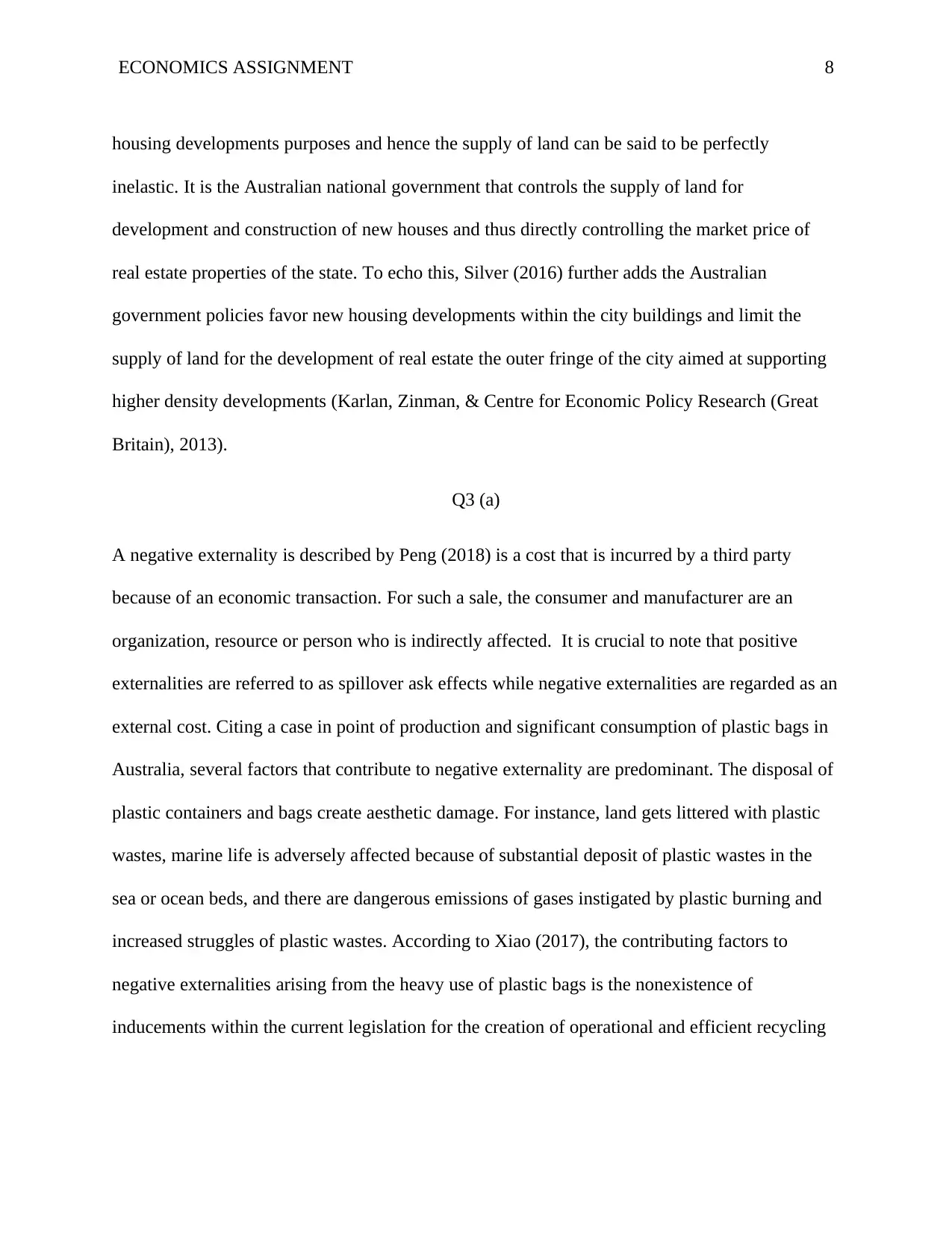
ECONOMICS ASSIGNMENT 8
housing developments purposes and hence the supply of land can be said to be perfectly
inelastic. It is the Australian national government that controls the supply of land for
development and construction of new houses and thus directly controlling the market price of
real estate properties of the state. To echo this, Silver (2016) further adds the Australian
government policies favor new housing developments within the city buildings and limit the
supply of land for the development of real estate the outer fringe of the city aimed at supporting
higher density developments (Karlan, Zinman, & Centre for Economic Policy Research (Great
Britain), 2013).
Q3 (a)
A negative externality is described by Peng (2018) is a cost that is incurred by a third party
because of an economic transaction. For such a sale, the consumer and manufacturer are an
organization, resource or person who is indirectly affected. It is crucial to note that positive
externalities are referred to as spillover ask effects while negative externalities are regarded as an
external cost. Citing a case in point of production and significant consumption of plastic bags in
Australia, several factors that contribute to negative externality are predominant. The disposal of
plastic containers and bags create aesthetic damage. For instance, land gets littered with plastic
wastes, marine life is adversely affected because of substantial deposit of plastic wastes in the
sea or ocean beds, and there are dangerous emissions of gases instigated by plastic burning and
increased struggles of plastic wastes. According to Xiao (2017), the contributing factors to
negative externalities arising from the heavy use of plastic bags is the nonexistence of
inducements within the current legislation for the creation of operational and efficient recycling
housing developments purposes and hence the supply of land can be said to be perfectly
inelastic. It is the Australian national government that controls the supply of land for
development and construction of new houses and thus directly controlling the market price of
real estate properties of the state. To echo this, Silver (2016) further adds the Australian
government policies favor new housing developments within the city buildings and limit the
supply of land for the development of real estate the outer fringe of the city aimed at supporting
higher density developments (Karlan, Zinman, & Centre for Economic Policy Research (Great
Britain), 2013).
Q3 (a)
A negative externality is described by Peng (2018) is a cost that is incurred by a third party
because of an economic transaction. For such a sale, the consumer and manufacturer are an
organization, resource or person who is indirectly affected. It is crucial to note that positive
externalities are referred to as spillover ask effects while negative externalities are regarded as an
external cost. Citing a case in point of production and significant consumption of plastic bags in
Australia, several factors that contribute to negative externality are predominant. The disposal of
plastic containers and bags create aesthetic damage. For instance, land gets littered with plastic
wastes, marine life is adversely affected because of substantial deposit of plastic wastes in the
sea or ocean beds, and there are dangerous emissions of gases instigated by plastic burning and
increased struggles of plastic wastes. According to Xiao (2017), the contributing factors to
negative externalities arising from the heavy use of plastic bags is the nonexistence of
inducements within the current legislation for the creation of operational and efficient recycling
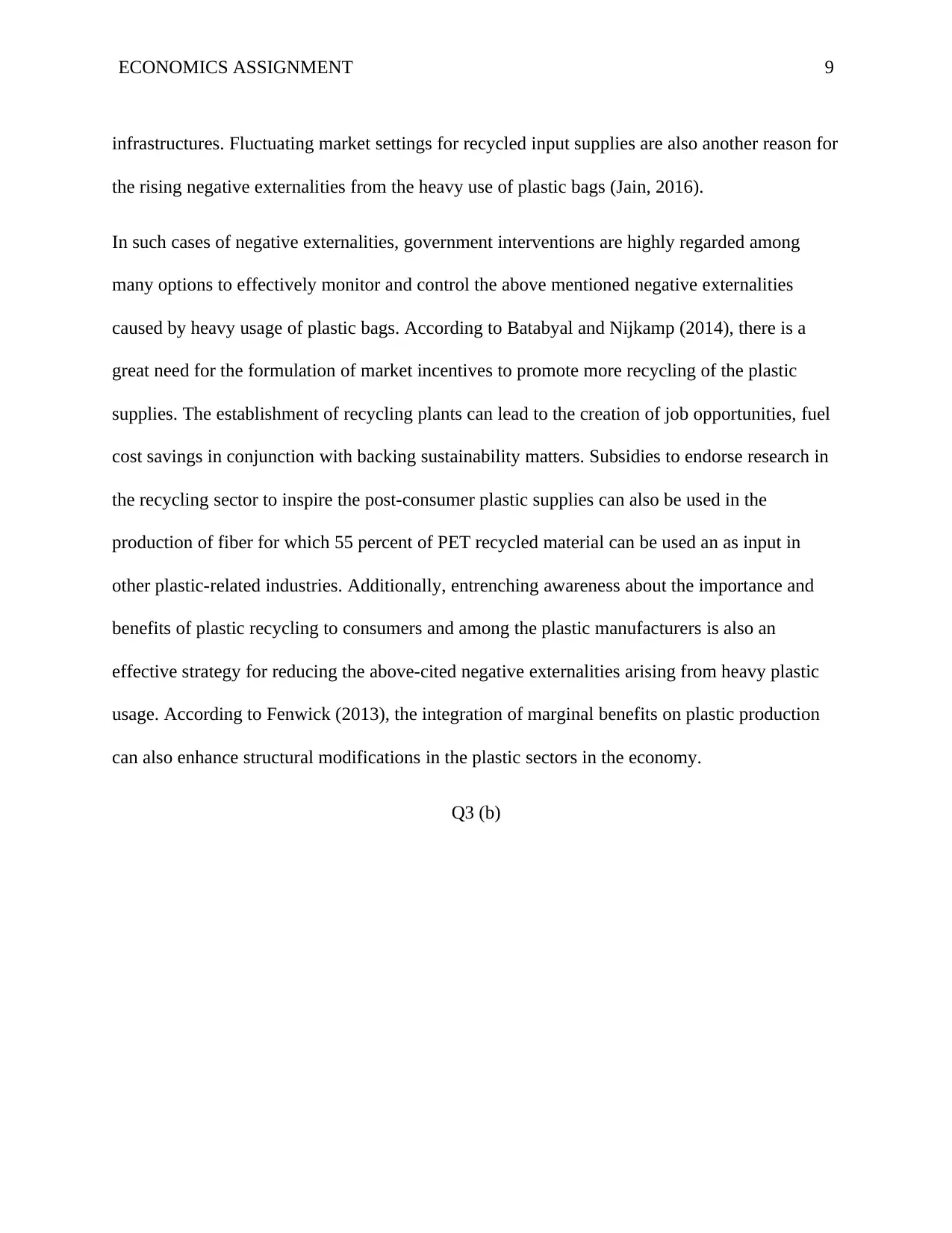
ECONOMICS ASSIGNMENT 9
infrastructures. Fluctuating market settings for recycled input supplies are also another reason for
the rising negative externalities from the heavy use of plastic bags (Jain, 2016).
In such cases of negative externalities, government interventions are highly regarded among
many options to effectively monitor and control the above mentioned negative externalities
caused by heavy usage of plastic bags. According to Batabyal and Nijkamp (2014), there is a
great need for the formulation of market incentives to promote more recycling of the plastic
supplies. The establishment of recycling plants can lead to the creation of job opportunities, fuel
cost savings in conjunction with backing sustainability matters. Subsidies to endorse research in
the recycling sector to inspire the post-consumer plastic supplies can also be used in the
production of fiber for which 55 percent of PET recycled material can be used an as input in
other plastic-related industries. Additionally, entrenching awareness about the importance and
benefits of plastic recycling to consumers and among the plastic manufacturers is also an
effective strategy for reducing the above-cited negative externalities arising from heavy plastic
usage. According to Fenwick (2013), the integration of marginal benefits on plastic production
can also enhance structural modifications in the plastic sectors in the economy.
Q3 (b)
infrastructures. Fluctuating market settings for recycled input supplies are also another reason for
the rising negative externalities from the heavy use of plastic bags (Jain, 2016).
In such cases of negative externalities, government interventions are highly regarded among
many options to effectively monitor and control the above mentioned negative externalities
caused by heavy usage of plastic bags. According to Batabyal and Nijkamp (2014), there is a
great need for the formulation of market incentives to promote more recycling of the plastic
supplies. The establishment of recycling plants can lead to the creation of job opportunities, fuel
cost savings in conjunction with backing sustainability matters. Subsidies to endorse research in
the recycling sector to inspire the post-consumer plastic supplies can also be used in the
production of fiber for which 55 percent of PET recycled material can be used an as input in
other plastic-related industries. Additionally, entrenching awareness about the importance and
benefits of plastic recycling to consumers and among the plastic manufacturers is also an
effective strategy for reducing the above-cited negative externalities arising from heavy plastic
usage. According to Fenwick (2013), the integration of marginal benefits on plastic production
can also enhance structural modifications in the plastic sectors in the economy.
Q3 (b)
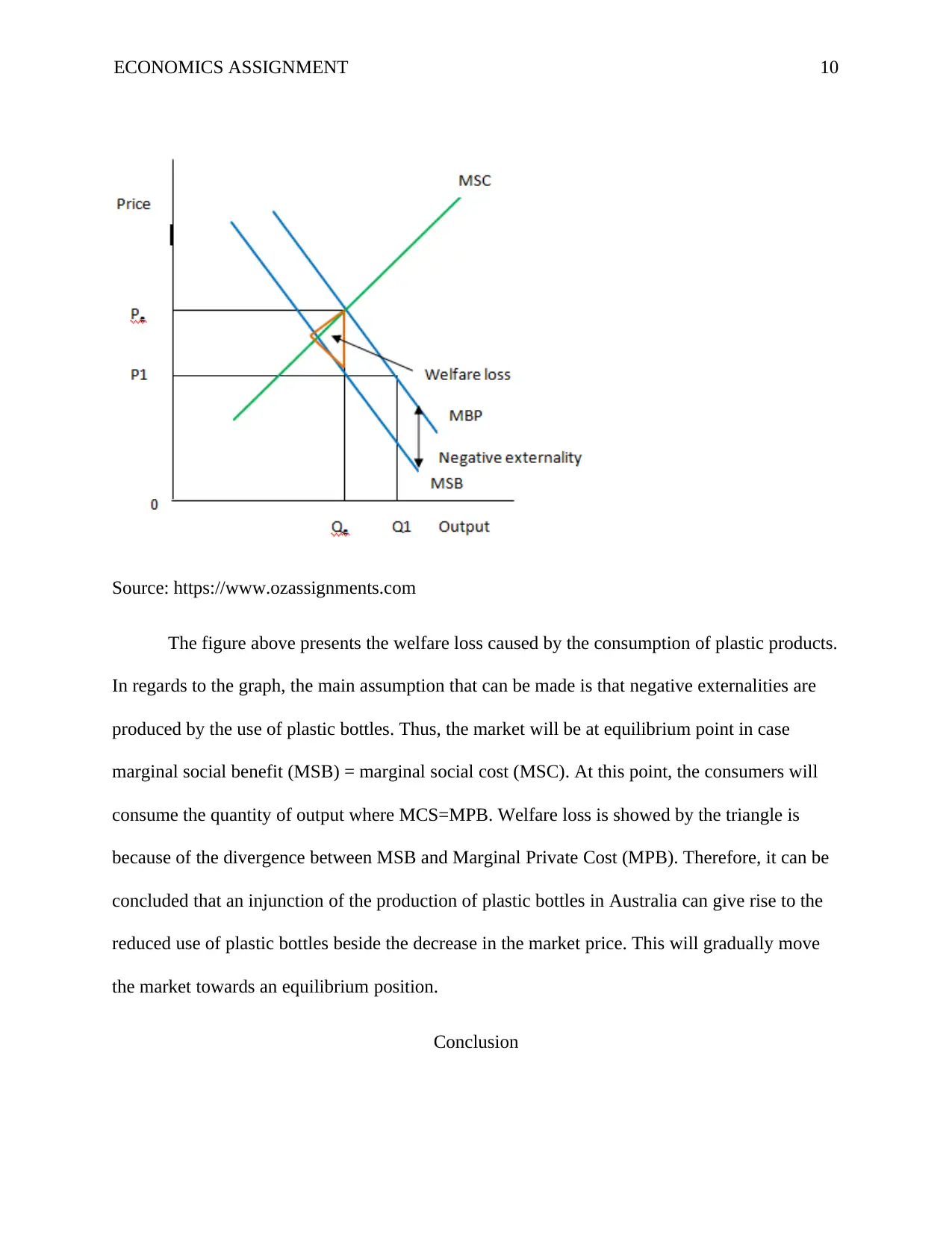
ECONOMICS ASSIGNMENT 10
Source: https://www.ozassignments.com
The figure above presents the welfare loss caused by the consumption of plastic products.
In regards to the graph, the main assumption that can be made is that negative externalities are
produced by the use of plastic bottles. Thus, the market will be at equilibrium point in case
marginal social benefit (MSB) = marginal social cost (MSC). At this point, the consumers will
consume the quantity of output where MCS=MPB. Welfare loss is showed by the triangle is
because of the divergence between MSB and Marginal Private Cost (MPB). Therefore, it can be
concluded that an injunction of the production of plastic bottles in Australia can give rise to the
reduced use of plastic bottles beside the decrease in the market price. This will gradually move
the market towards an equilibrium position.
Conclusion
Source: https://www.ozassignments.com
The figure above presents the welfare loss caused by the consumption of plastic products.
In regards to the graph, the main assumption that can be made is that negative externalities are
produced by the use of plastic bottles. Thus, the market will be at equilibrium point in case
marginal social benefit (MSB) = marginal social cost (MSC). At this point, the consumers will
consume the quantity of output where MCS=MPB. Welfare loss is showed by the triangle is
because of the divergence between MSB and Marginal Private Cost (MPB). Therefore, it can be
concluded that an injunction of the production of plastic bottles in Australia can give rise to the
reduced use of plastic bottles beside the decrease in the market price. This will gradually move
the market towards an equilibrium position.
Conclusion
Secure Best Marks with AI Grader
Need help grading? Try our AI Grader for instant feedback on your assignments.
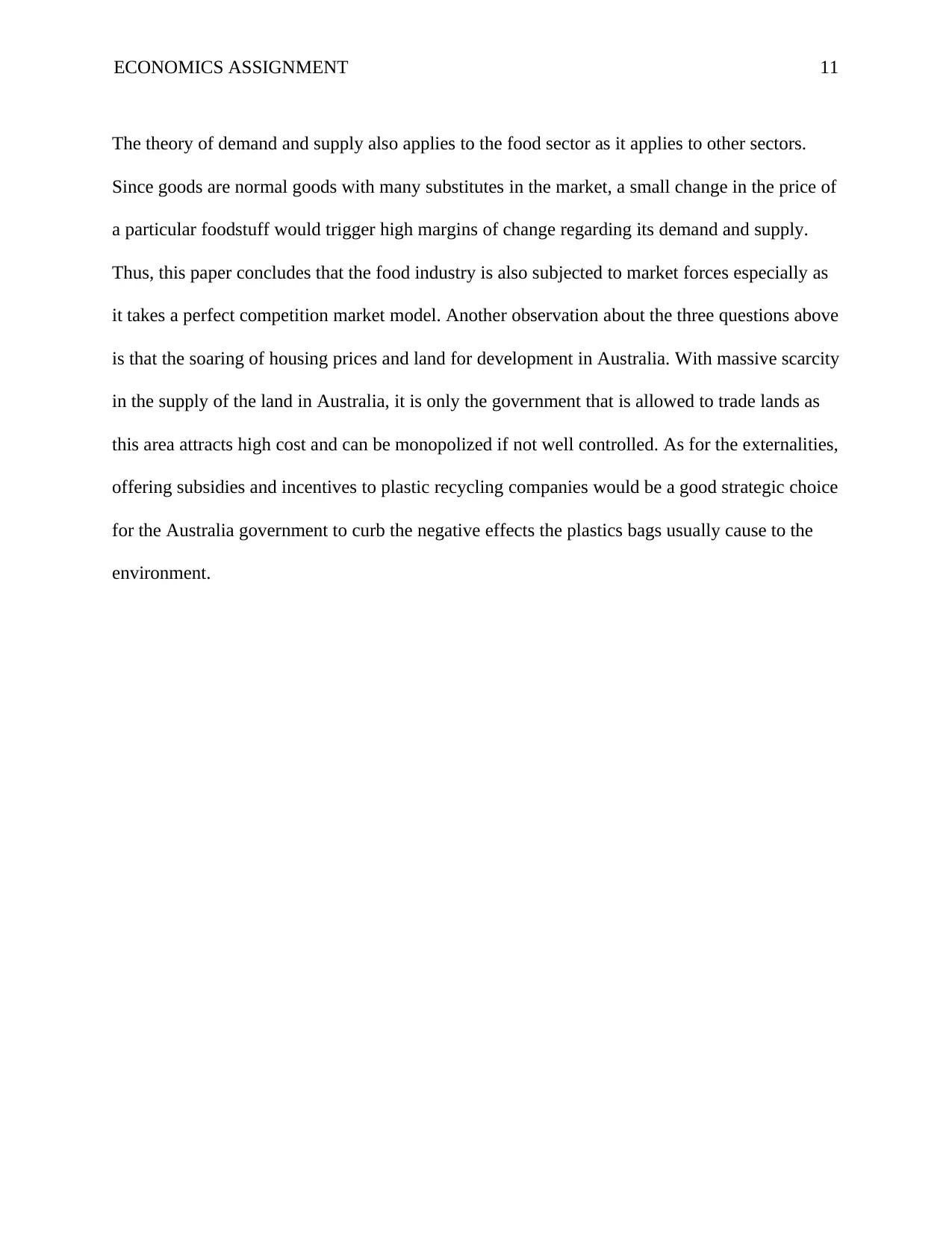
ECONOMICS ASSIGNMENT 11
The theory of demand and supply also applies to the food sector as it applies to other sectors.
Since goods are normal goods with many substitutes in the market, a small change in the price of
a particular foodstuff would trigger high margins of change regarding its demand and supply.
Thus, this paper concludes that the food industry is also subjected to market forces especially as
it takes a perfect competition market model. Another observation about the three questions above
is that the soaring of housing prices and land for development in Australia. With massive scarcity
in the supply of the land in Australia, it is only the government that is allowed to trade lands as
this area attracts high cost and can be monopolized if not well controlled. As for the externalities,
offering subsidies and incentives to plastic recycling companies would be a good strategic choice
for the Australia government to curb the negative effects the plastics bags usually cause to the
environment.
The theory of demand and supply also applies to the food sector as it applies to other sectors.
Since goods are normal goods with many substitutes in the market, a small change in the price of
a particular foodstuff would trigger high margins of change regarding its demand and supply.
Thus, this paper concludes that the food industry is also subjected to market forces especially as
it takes a perfect competition market model. Another observation about the three questions above
is that the soaring of housing prices and land for development in Australia. With massive scarcity
in the supply of the land in Australia, it is only the government that is allowed to trade lands as
this area attracts high cost and can be monopolized if not well controlled. As for the externalities,
offering subsidies and incentives to plastic recycling companies would be a good strategic choice
for the Australia government to curb the negative effects the plastics bags usually cause to the
environment.
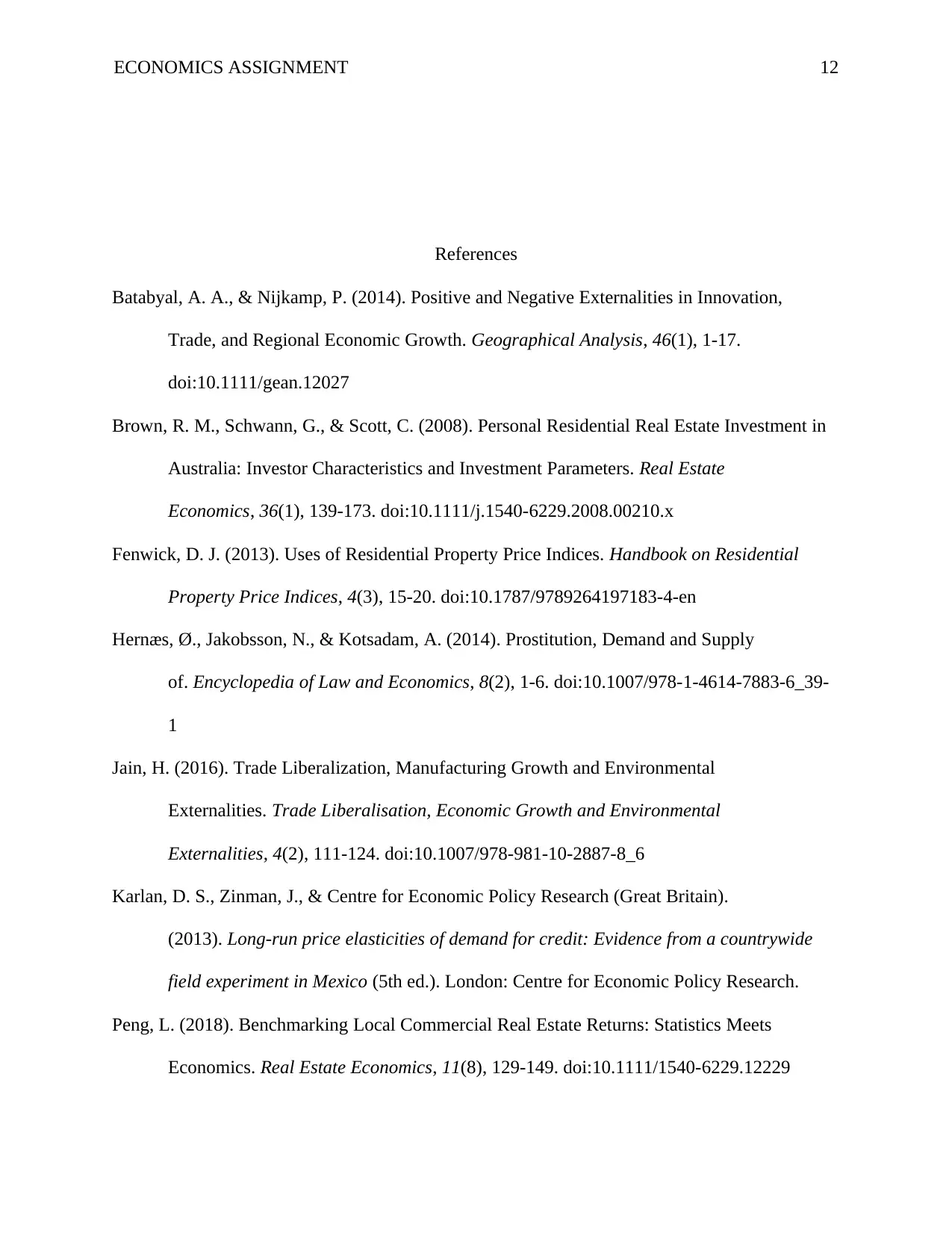
ECONOMICS ASSIGNMENT 12
References
Batabyal, A. A., & Nijkamp, P. (2014). Positive and Negative Externalities in Innovation,
Trade, and Regional Economic Growth. Geographical Analysis, 46(1), 1-17.
doi:10.1111/gean.12027
Brown, R. M., Schwann, G., & Scott, C. (2008). Personal Residential Real Estate Investment in
Australia: Investor Characteristics and Investment Parameters. Real Estate
Economics, 36(1), 139-173. doi:10.1111/j.1540-6229.2008.00210.x
Fenwick, D. J. (2013). Uses of Residential Property Price Indices. Handbook on Residential
Property Price Indices, 4(3), 15-20. doi:10.1787/9789264197183-4-en
Hernæs, Ø., Jakobsson, N., & Kotsadam, A. (2014). Prostitution, Demand and Supply
of. Encyclopedia of Law and Economics, 8(2), 1-6. doi:10.1007/978-1-4614-7883-6_39-
1
Jain, H. (2016). Trade Liberalization, Manufacturing Growth and Environmental
Externalities. Trade Liberalisation, Economic Growth and Environmental
Externalities, 4(2), 111-124. doi:10.1007/978-981-10-2887-8_6
Karlan, D. S., Zinman, J., & Centre for Economic Policy Research (Great Britain).
(2013). Long-run price elasticities of demand for credit: Evidence from a countrywide
field experiment in Mexico (5th ed.). London: Centre for Economic Policy Research.
Peng, L. (2018). Benchmarking Local Commercial Real Estate Returns: Statistics Meets
Economics. Real Estate Economics, 11(8), 129-149. doi:10.1111/1540-6229.12229
References
Batabyal, A. A., & Nijkamp, P. (2014). Positive and Negative Externalities in Innovation,
Trade, and Regional Economic Growth. Geographical Analysis, 46(1), 1-17.
doi:10.1111/gean.12027
Brown, R. M., Schwann, G., & Scott, C. (2008). Personal Residential Real Estate Investment in
Australia: Investor Characteristics and Investment Parameters. Real Estate
Economics, 36(1), 139-173. doi:10.1111/j.1540-6229.2008.00210.x
Fenwick, D. J. (2013). Uses of Residential Property Price Indices. Handbook on Residential
Property Price Indices, 4(3), 15-20. doi:10.1787/9789264197183-4-en
Hernæs, Ø., Jakobsson, N., & Kotsadam, A. (2014). Prostitution, Demand and Supply
of. Encyclopedia of Law and Economics, 8(2), 1-6. doi:10.1007/978-1-4614-7883-6_39-
1
Jain, H. (2016). Trade Liberalization, Manufacturing Growth and Environmental
Externalities. Trade Liberalisation, Economic Growth and Environmental
Externalities, 4(2), 111-124. doi:10.1007/978-981-10-2887-8_6
Karlan, D. S., Zinman, J., & Centre for Economic Policy Research (Great Britain).
(2013). Long-run price elasticities of demand for credit: Evidence from a countrywide
field experiment in Mexico (5th ed.). London: Centre for Economic Policy Research.
Peng, L. (2018). Benchmarking Local Commercial Real Estate Returns: Statistics Meets
Economics. Real Estate Economics, 11(8), 129-149. doi:10.1111/1540-6229.12229
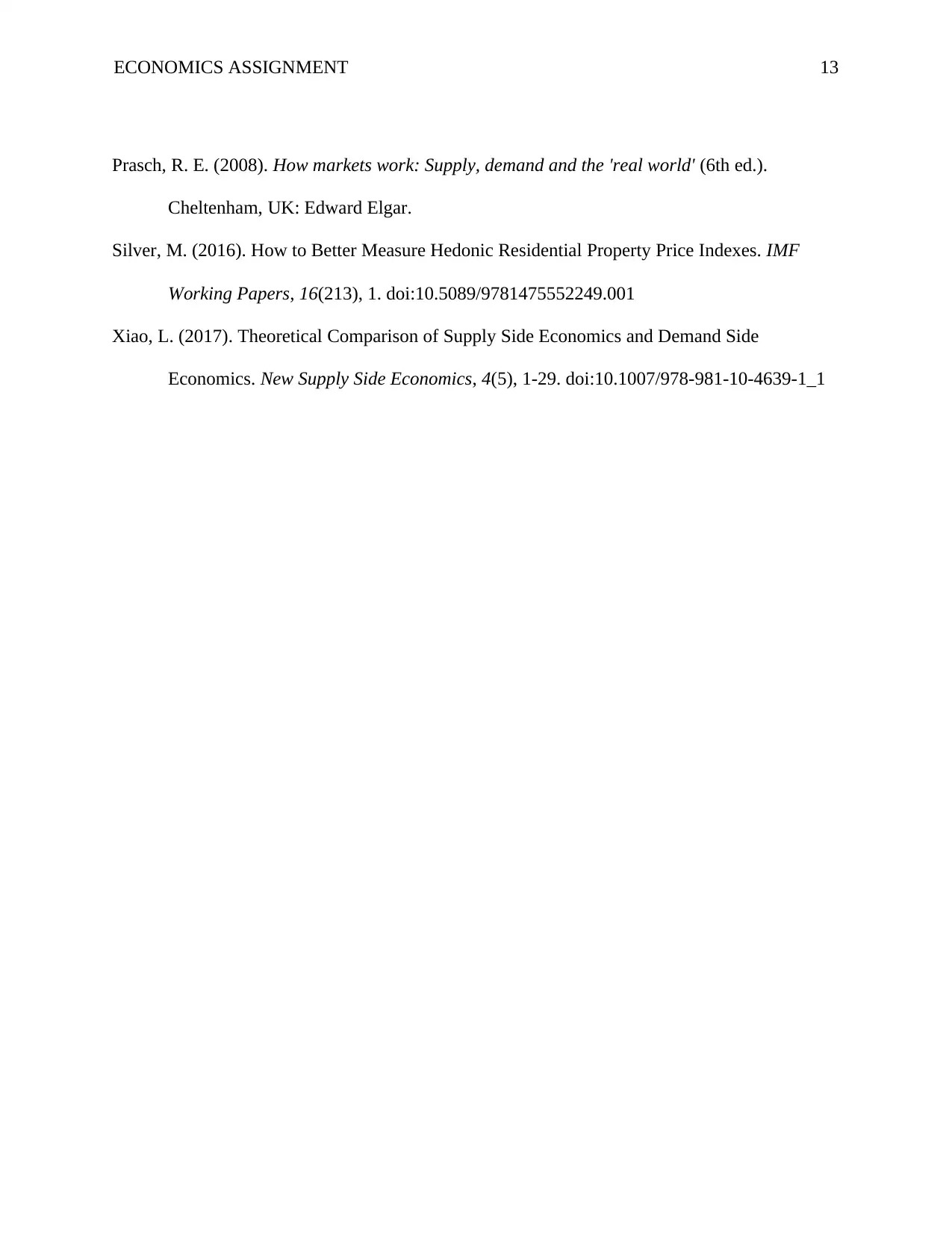
ECONOMICS ASSIGNMENT 13
Prasch, R. E. (2008). How markets work: Supply, demand and the 'real world' (6th ed.).
Cheltenham, UK: Edward Elgar.
Silver, M. (2016). How to Better Measure Hedonic Residential Property Price Indexes. IMF
Working Papers, 16(213), 1. doi:10.5089/9781475552249.001
Xiao, L. (2017). Theoretical Comparison of Supply Side Economics and Demand Side
Economics. New Supply Side Economics, 4(5), 1-29. doi:10.1007/978-981-10-4639-1_1
Prasch, R. E. (2008). How markets work: Supply, demand and the 'real world' (6th ed.).
Cheltenham, UK: Edward Elgar.
Silver, M. (2016). How to Better Measure Hedonic Residential Property Price Indexes. IMF
Working Papers, 16(213), 1. doi:10.5089/9781475552249.001
Xiao, L. (2017). Theoretical Comparison of Supply Side Economics and Demand Side
Economics. New Supply Side Economics, 4(5), 1-29. doi:10.1007/978-981-10-4639-1_1
1 out of 13
Related Documents
Your All-in-One AI-Powered Toolkit for Academic Success.
+13062052269
info@desklib.com
Available 24*7 on WhatsApp / Email
![[object Object]](/_next/static/media/star-bottom.7253800d.svg)
Unlock your academic potential
© 2024 | Zucol Services PVT LTD | All rights reserved.




